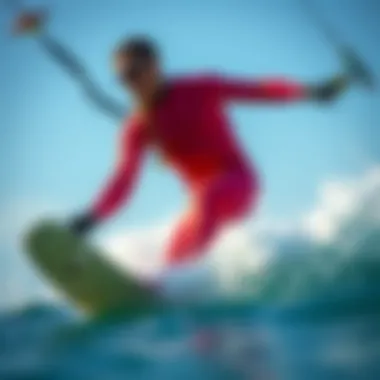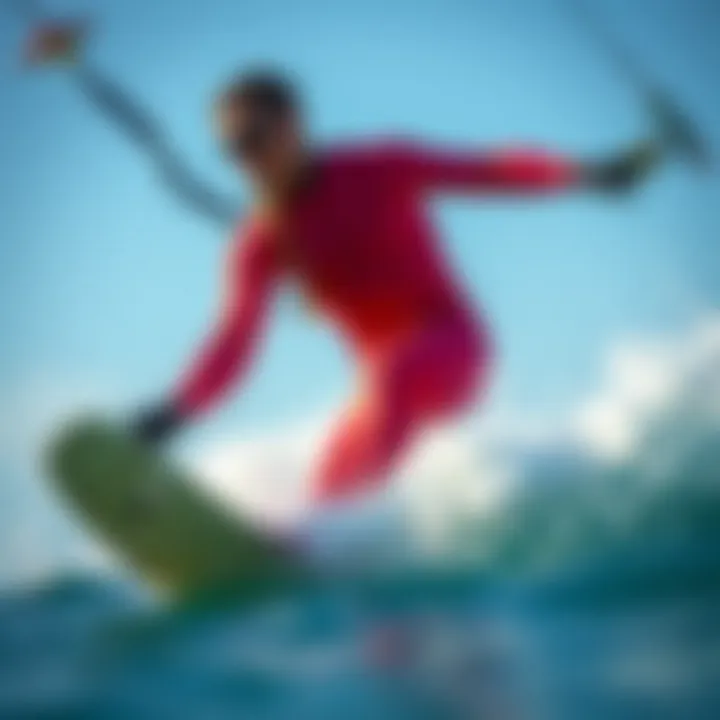Exploring the Zipperless Wetsuit: A Comprehensive Overview


Intro
The evolution of wetsuits has come a long way from the classic designs that featured zippers, often known for their cumbersome nature. Recently, a fresh wave of innovation has emerged in the form of zipperless wetsuits, which present a unique approach to water sports apparel. This article delves into the structural advantages and material innovations that zipperless wetsuits offer, with a keen focus on their practical implications for kiteboarding enthusiasts.
Understanding the importance of these designs is crucial, as kiteboarding itself demands functionality, flexibility, and protection from the elements. The absence of zippers not only enhances the comfort and fit of the wetsuit but also aligns with the growing push towards streamlined, minimalist gear in water sports. Moreover, with kiteboarding gaining traction globally, defining the nuances of equipment—especially groundbreaking designs—becomes all the more pivotal.
In the following sections, we’ll explore the essential gear every kiteboarder should consider, with a special spotlight on the zipperless wetsuits. This journey will take us through the fundamental aspects of safety, training techniques, and much more, ultimately painting a comprehensive picture of how innovations are reshaping the kiteboarding landscape.
Stay tuned as we guide you through these essential themes and uncover what makes zipperless wetsuits a game changer for kiteboarders.
Preamble to Zipperless Wetsuits
Understanding zipperless wetsuits is crucial for any water sports enthusiasts, especially kiteboarders, who seek innovative solutions to enhance their performance. These suits represent a shift in design philosophy, moving away from traditional fastening methods to a more seamless approach. The implications of this design change are significant, offering benefits that go beyond mere aesthetics.
Definition and Evolution
Zipperless wetsuits are, as their name suggests, wetsuits that do not incorporate a zipper mechanism. Instead, they utilize a variety of innovative materials and construction techniques to ensure a snug fit without the need for zippers. The evolution of these suits can be traced back to the increasing demand for comfort and flexibility among athletes engaged in extreme sports. As surfers and kiteboarders pursued greater freedom of movement, manufacturers responded by developing zipperless options, paving the way for a new standard in wetsuit design.
The absence of a zipper not only enhances flexibility but also reduces the likelihood of water entry through the seams, which often occurs in traditional suits. Early zipperless designs were simple but effective. They marked a significant step in the evolution of wetsuits, transitioning from basic neoprene to advanced materials like Yamamoto eco-friendly neoprene, which is lighter and provides superior thermal insulation.
Comparison With Traditional Wetsuits
When comparing zipperless wetsuits with conventional zipper counterparts, several key differences emerge. The primary distinction lies in the fit and comfort level. Without the rigid structure of zippers, zipperless wetsuits provide a more streamlined fit closely hugging the body. This is particularly advantageous for kiteboarding, where agility can make or break a ride.
In terms of thermal regulation, zipperless designs often outperform traditional wetsuits. The smooth surface and absence of zippers create fewer opportunities for cold water to seep in, keeping riders warmer during extended sessions on the water. Moreover, these suits tend to have a cleaner aesthetic, appealing to those who prefer a sleeker look.
However, it would be remiss not to recognize that traditional wetsuits still hold appeal for many. The ease of donning and doffing a zipper suit can be a significant factor, particularly for beginners or those who prioritize convenience. Each type has its own merits and serves different user needs, but zipperless wetsuits are gaining traction for their performance-enhancing features.
Design Features of Zipperless Wetsuits
The design features of zipperless wetsuits mark a revolutionary shift in how water sports enthusiasts experience their gear. Unlike traditional wetsuits, which often battle the common woes of zippers, zipperless wetsuits boast streamlined aesthetic and functional benefits that cater specifically to active users. The focus on innovative design elements has resulted in a superior alternative that enhances performance, comfort, and ease of movement.
Material Selection and Innovation
Material choice is critical in crafting a wetsuit that performs well in the water. The zip-less models often use advanced neoprene material, which is not only lightweight but also offers optimal thermal protection. For instance, materials like Yamamoto neoprene are known for their eco-friendliness yet still provide exceptional flexibility and durability. The stretchy nature of these materials allows for complete freedom of movement, vital for kiteboarding where agility is paramount.
Moreover, manufacturers incorporate innovations such as thermal lining and water-repellent coatings. These advancements actively work to keep the body warm without adding unnecessary bulk. Many kiteboarders rave about how these features contribute to a more enjoyable riding experience, removing the limitations that traditional wetsuits may impose.
In essence, the thoughtful selection of materials in zipperless wetsuits not only improves their functionality but also supports an environmentally conscious approach, aligning well with the values of many modern adventurers.
Seam Construction Techniques
The construction of seams in zipperless wetsuits plays a pivotal role in their overall effectiveness and durability. Without the traditional zipper, the focus shifts to how the seams are engineered, with many brands opting for blind stitching or liquid seam technology. Blind stitching involves interlocking the fabric layers without fully piercing through them, reducing water penetration and enhancing insulation.
In contrast, liquid seam technology uses a specialized adhesive that reinforces the seams while maintaining flexibility. This technique significantly diminishes the likelihood of the seams tearing, especially during high-stress maneuvering during sports like kiteboarding.


The result? A wetsuit that not only fits snugly but one that can withstand the harsh demands of dynamic water sports. With enhanced waterproof properties and a body-hugging fit, kiteboarders can focus on their performance rather than worrying about discomfort or leaks.
"When I switched to a zipperless wetsuit, I immediately noticed the difference. No more tugging at the zipper; it felt like a second skin."
— Anonymous Kiteboarding Enthusiast
In summary, the innovative design elements—from material selection to seam construction—establish zipperless wetsuits as a premier choice for water sports lovers. Their combination of lightweight fabrics and strong seams create a reliable companion for the rigors of the waves.
Benefits of Using a Zipperless Wetsuit
The discussion around the benefits of using a zipperless wetsuit is of paramount importance, especially for kiteboarders and other water sports enthusiasts. With an increasing demand for innovative gear that enhances performance, this particular design has become quite the buzzword. The merits of zipperless wetsuits extend beyond just convenience; they have the potential to profoundly affect comfort levels, thermal management, and overall fit while engaging in water sports.
Enhanced Flexibility and Comfort
One of the standout features of zipperless wetsuits is their increased flexibility. When riding the waves, having the freedom of movement can be a game changer.
Unlike traditional wetsuits, which often have limited stretch at the zipper area, zipperless designs prioritize fluid motion. Imagine paddling out into the surf or maneuvering your kite without those pesky restrictions. The absence of a zipper means that the entire suit is crafted from uniform materials, allowing for a consistent stretch that adapts to your body. Many users have reported feeling as if they are wearing a second skin, with no pinching at the back or complications during transitions.
Moreover, the internal construction and close-fitting nature of these suits allow athletic bodies to move smoothly. It’s a step in the right direction for enthusiasts who relish deep-sea dives, crouching low for that perfect kiteboard launch, or simply relaxing in the surf without that tight sensation that a traditional zip might impose.
"A zipperless wetsuit feels like you’re slipping into something far more natural, instead of just gear. It opens up much more than just range of motion."
Improved Thermal Regulation
Another significant advantage is the thermal regulation capacity of zipperless wetsuits. Water temperature can feel frigid, especially during early morning sessions or in colder climates. The insulating nature of the materials used in zipperless designs works wonders to keep the core body temperature stable. Without a zipper, which can sometimes allow water to seep in, these suits usually maintain a tighter seal.
For kiteboarders, this is especially critical. Cold water can quickly sap energy and focus. A well-fitting zipperless wetsuit can trap warmth more effectively, giving you longer sessions and fewer distractions from the cold. Materials like neoprene are engineered to retain heat while allowing for moisture control. Even when things get a bit wild, some suits are designed to channel away excess water and maintain comfort.
In harsher conditions, this can be the difference between a thrilling session or a chilly slog home. After all, when you’re out there catching waves, you want to be focused on riding, not shivering.
Streamlined Fit
Finally, there's the streamlined fit that zipperless wetsuits often provide. Traditional wetsuits are criticized for their bulky feel, primarily around the zip area. This added bulk can cause drag, which is an enemy to optimal performance in any water sport, kiteboarding included.
Zipperless wetsuits, however, shape seamlessly around the body, enhancing hydrodynamics. They promote a sleek profile, significantly reducing resistance as one slices through the water or glides through the air on a kite. This reduced drag encourages more exhilarating maneuvers and potentially higher speeds.
Additionally, the streamlined factor can create a psychological boost. Confidence in one’s equipment translates to fewer worries and better focus on the sport itself.
Considerations for Kiteboarding Enthusiasts
When it comes to kiteboarding, the right gear can make or break the experience. As the sport demands agility, balance, and an unyielding connection to the water, a zipperless wetsuit could be an invaluable asset. Given the unique requirements of kiteboarding, there are several factors to consider regarding the use of zipperless wetsuits. Here, we'll dive into suitability for different conditions and provide insights on proper sizing and fit recommendations.
Suitability for Different Conditions
Kiteboarding often sees varying water conditions, from warm breezes to brisk seas. How a wetsuit performs in these climates is crucial.
- Warm Water Conditions: In tropical or warm weather, the lack of a zipper can be beneficial. Zipperless designs tend to have smoother, seamless constructions around the torso, which promotes freedom of movement. Less water intrusion means riders can feel cooler without the bulk of thick neoprene in warmer temperatures.
- Cold Water Conditions: Conversely, during colder spells, insulation becomes vital. Zipperless wetsuits use innovative layering techniques that trap heat close to the body, while still allowing excess water to escape, acting like a thermal barrier. Riders in these conditions often look for suits made with heavier materials, which can provide extra warmth while still fitting snugly without zippers.
- Variable Weather Conditions: Kiteboarding often involves sudden changes in climate, so wearing a wetsuit that adapts easily to temperature shifts is essential. A flexible zipperless suit allows riders to adjust for warmer or cooler weather, matching their comfort needs without the hassle of fumbling with zippers.


Sizing and Fit Recommendations
The fit of a wetsuit significantly impacts performance. A good suit allows for unrestricted movement while remaining snug enough to minimize water entry. Proper sizing is especially crucial for kiteboarders because a proper fit aids in maintaining core warmth and optimizing responsiveness.
- Understanding Sizing Charts: Each brand has its own sizing requirements. Consult the specific size chart available on the manufacturer's website before making a purchase. Riders should measure their chest, waist, and inseam to ensure an appropriate fit. Keeping in mind body dimensions can help in navigating through possible sizing irregularities.
- Try Before You Buy: If possible, consider trying on the wetsuit in a store. Ensure the suit hugs your body without being too tight, particularly at the shoulders and arms, allowing for full movement while holding the kite line.
- Leave Room for Layers: Depending on the conditions, some riders may opt to layer under their wetsuits. This can take the form of thermal tops or rash guards. As such, it's wise to factor in extra space to accommodate for these layers without compromising the snugness of the wetsuit.
- Check for Comfort: Lastly and perhaps most importantly, testers should be able to perform a range of motions essential for kiteboarding, such as twisting and reaching, without hindrance. A zipperless wetsuit should feel almost as if it's a second skin, but without any restrictive tightness.
Challenges and Limitations of Zipperless Wetsuits
While zipperless wetsuits offer several enticing advantages, particularly for kiteboarding enthusiasts, it's crucial to examine the challenges and limitations tied to their design. Understanding these facets helps users make informed decisions about their gear and prepares them for potential issues that may arise in various conditions or situations.
Durability Concerns
One of the most pressing issues associated with zipperless wetsuits is their durability. Unlike traditional wetsuits, which often have zippers that can be replaced or repaired, a zipperless design lacks this feature. This may seem minor at first glance, yet over time, wear and tear on the seams and fabric might present significant challenges.
The absence of a zipper means that the material must bear the full brunt of tension when entering or exiting the suit. If users are not careful, the potential for overstretching the material grows, possibly leading to tears or fabric degradation sooner than expected. That said, many manufacturers are now utilizing advanced materials in production—such as neoprene blends with added resilience—to mitigate these durability woes.
In the kiteboarding community, users often express concern over their gear being exposed to harsh elements like sun, saltwater, and wind. Therefore, regularly inspecting their suits, particularly in areas prone to wear, becomes essential.
Communities like Reddit often have threads discussing how particular brands hold up over time, offering prospective purchasers a glimpse into the real-world durability of various models.
Accessibility Issues
Accessibility is another noteworthy consideration when evaluating zipperless wetsuits. The innovative designs can indeed make it tricky to put on or take off the suit, especially for individuals who may not possess an ideal level of flexibility or strength.
Zippers are convenient; they allow for rapid entry and exit, which is particularly vital in situations where time is of the essence, such as preparing to catch the next wave or changing on a windy beach. For those solo riding or beginners who might struggle with self-dressing, this can become a logistical headache, adding an extra layer of frustration.
Moreover, users with certain physical limitations might find it difficult to navigate the tighter fit of a zipperless wetsuit. The suit's snugness can be a double-edged sword: it enhances thermal regulation but can inhibit movement during the donning process. This has led to discussions among users on platforms like Facebook, where they share advice and tips for zipping up sans zipper, highlighting the importance of community support around wearers' experiences.
The conversation surrounding zipperless wetsuits ultimately suggests that while they represent significant innovation in wetsuit technology, they come with their own set of challenges that users should weigh carefully against their preferences and needs.
Expert Opinions and User Experiences
In any discussion regarding the zipperless wetsuit, one cannot overlook the significant weight of expert opinions and user experiences. These insights serve not only as a gauge of the technology's performance but also as a reflection of its reception among seasoned practitioners. Understanding how kiteboarding professionals and everyday users perceive zipperless wetsuits adds layers of depth to our discussion, enabling us to assess their real-world functionality against the backdrop of technological claims.
Feedback from Kiteboarding Professionals
Kiteboarding professionals represent a diverse range of experiences, from competitive athletes to instructors teaching beginners how to ride the waves. Their feedback is often rooted in practical applications.
Professionals have generally noted a marked improvement in mobility when wearing zipperless wetsuits. For instance, John, a seasoned kiteboarding instructor based out of Maui, shared his perspective, emphasizing that the absence of zippers allows for a streamlined experience. "The flexibility is phenomenal. I can maneuver without the suit pulling or restricting my movements like some traditional suits do. It feels like I’m not even wearing anything," he noted.
Moreover, concerns regarding thermal regulation have been addressed in the feedback given by professionals. Some kiteboarders reported maintaining optimal body temperature longer than with their previous zippered options. This is particularly relevant in varying water temperatures, where staying warm yet comfortable is paramount.
However, it’s essential to consider that some professionals also express caution. There are comments about durability, especially when tackling more aggressive water sports.
Community Testimonials


Individuals from the kiteboarding community often provide the real-world perspective that elevates the overall understanding of zipperless wetsuits.
Many enthusiasts have taken to forums such as Reddit to share their experiences. A participant known as "KiteAddict90" recounted how his recent purchase of a zipperless wetsuit transformed his riding style. He mentioned, "I’ve noticed my rides are longer and more enjoyable without the constant hassle of adjusting a zipper or feeling constricted by the suit."
In a similar vein, a post on a dedicated kiteboarding Facebook group sparked a lively discussion around its advantages and setbacks. Users expressed how the seamless design led to less chafing, particularly in choppy water conditions. One user stated, "I used to come home with red marks where the zipper would rub against my skin; that’s a thing of the past now."
However, alongside the positive remarks, there were also voices of caution regarding the learning curve associated with donning and doffing the suit. A few users highlighted the complexity of putting on a snug-fitting zipperless wetsuit, noting it takes some getting used to but ultimately is worth the effort.
"Ultimately, whether you love or hate the zipperless wetsuit often boils down to personal preference and usage patterns; it's not a one-size-fits-all solution," stated an avid kiteboarder on the platform.
Industry Impact of Zipperless Technology
The advent of zipperless wetsuits marks a significant turning point not only in the design of wetsuits but in the broader landscape of water sports apparel. Their development reflects a shift towards prioritizing usability and performance alongside innovation. With kiteboarding gaining traction as a favored activity among adventure seekers, the adoption of zipperless technology appears to be an essential response to the evolving needs of athletes and enthusiasts. As the industry embraces this change, several specific elements emerge that highlight the importance of zipperless wetsuits.
First and foremost, there’s the emphasis on performance enhancement. Zipperless wetsuits allow for a more streamlined fit, reducing drag while riding the waves. This characteristic is particularly crucial for kiteboarders, where agility and fluid movements can make all the difference in performance. Customer feedback consistently notes that these suits provide a feeling of being "one with the water", allowing them to maneuver effortlessly, enhancing their overall experience on the water.
Market Trends and Shifts
The market for wetsuits has seen notable shifts recently, as consumers increasingly seek products that not only serve functionality but also align with sustainable practices. Zipperless wetsuits often utilize advanced materials that are more environmentally friendly. As awareness about environmental issues grows, brands that emphasize sustainable innovation position themselves favorably within competitive markets. This trend is also matched by a growing interest from manufacturers in experimenting with construction methods that reduce waste. As users increasingly place value on sustainability, the zipperless suits are becoming more relevant than ever.
Moreover, the effective marketing strategies employed by brands in promoting zipperless wetsuits are reshaping purchasing decisions. Testimonials from kiteboarding professionals become pivotal, illustrating real success stories that act as endorsements for potential buyers. Seeing skilled athletes thrive in zipperless designs encourages recreational participants to reconsider their own gear choices, reflecting a collective trend towards embracing new technology.
Comparison with Other Innovations
When comparing zipperless wetsuits to other innovations within the realm of water sports gear, it’s essential to assess what sets them apart. Alternatives such as traditional wetsuits still maintain a strong presence in the market, yet they have begun to feel outdated next to the increasing versatility offered by zipperless options.
- Less Restrictive Design: Unlike typical wetsuits, which often feel constrictive due to zippers, zipperless designs boast a more natural fit. This design philosophy caters to the dynamic movements of kiteboarders, enabling them to perform without the hindrance of bulky closures.
- Ease of Use: In a sport where timing is everything, the simplicity of slipping into a zipperless wet suit without fiddling with zippers is a considerable advantage. This ease benefits not only the seasoned riders but also newcomers who appreciate user-friendly equipment.
- Aesthetic Appeal: The aesthetic draw of zipperless wetsuits adds another layer of attractiveness. Their sleek designs resonate with a younger demographic that appreciates style alongside function, which further influences their popularity in the market.
Ultimately, the impact of zipperless technology reaches beyond individual user experiences. It ventures into the realms of sustainability, marketing strategy, and design evolution, driving substantial change within the industry. As brands and consumers continue to engage with this innovation, the future of wetsuit technology appears promising and expansive.
Ending: The Future of Wetsuit Design
In a world where water sports continue to evolve, the zipperless wetsuit stands as a game-changer. This design shift represents not just an improvement in functionality, but a broader reimagination of the relationship between the athlete and their gear. As kiteboarding enthusiasts gear up, the relevance of these wetsuits cannot be overstated. Not only do they offer enhanced comfort and performance, but they also reflect ongoing innovations in material science and design that can redefine our approach to aquatic sports.
Final Thoughts on Zipperless Technology
The transition to zipperless technology signals a significant moment for water sports gear. One of the standout features is the remarkable ease of use this new design affords. Without the cumbersome zipper, sliding into the suit becomes a simple task, making it more accessible for everyone. This design can help eliminate the frustration that often comes with traditional wetsuits.
Moreover, the continuous drive for innovation in this area is evident in how manufacturers are approaching materials. The incorporation of advanced elastomers and smart fabrics means that these suits not only retain warmth but excel in flexibility, granting kiteboarders the freedom to maneuver effortlessly on water. The streamlined construction aligns with the sleek aesthetic many modern athletes desire, adding an air of elegance to functionality.
"Zipperless wetsuits have changed the way we think about performance gear—they’re not just tools, they’re an extension of who we are on the water."
Potential Developments in Wetsuit Engineering
As we look to the horizon, the fusion of advanced technology with wetsuit engineering appears to only be gaining momentum. In the coming years, we might see even more innovative designs that leverage cutting-edge materials, like bioplastics and temperature-regulating polymers. These developments may lead to suits that not only perform better under different conditions but are also kinder to the environment.
Furthermore, collaboration between technologists and designers could yield custom-fit options based on data gleaned from performance analytics. Imagine a wetsuit that adjusts its fit dynamically based on activity levels and water conditions, maximizing the athlete's experience.
As research and innovative practices expand, the industry could also see greater sustainability practices, such as recycling used wetsuits or utilizing less harmful manufacturing processes. The potential advancements in this field are promising and suggest a future where our gear evolves in sync with our environmental responsibilities.
In closing, the evolution of wetsuits—especially zipperless designs—brings forth exciting opportunities for kiteboarders and other water sports enthusiasts. Each shred of innovation pushes boundaries and opens up new possibilities for performance and sustainability.



